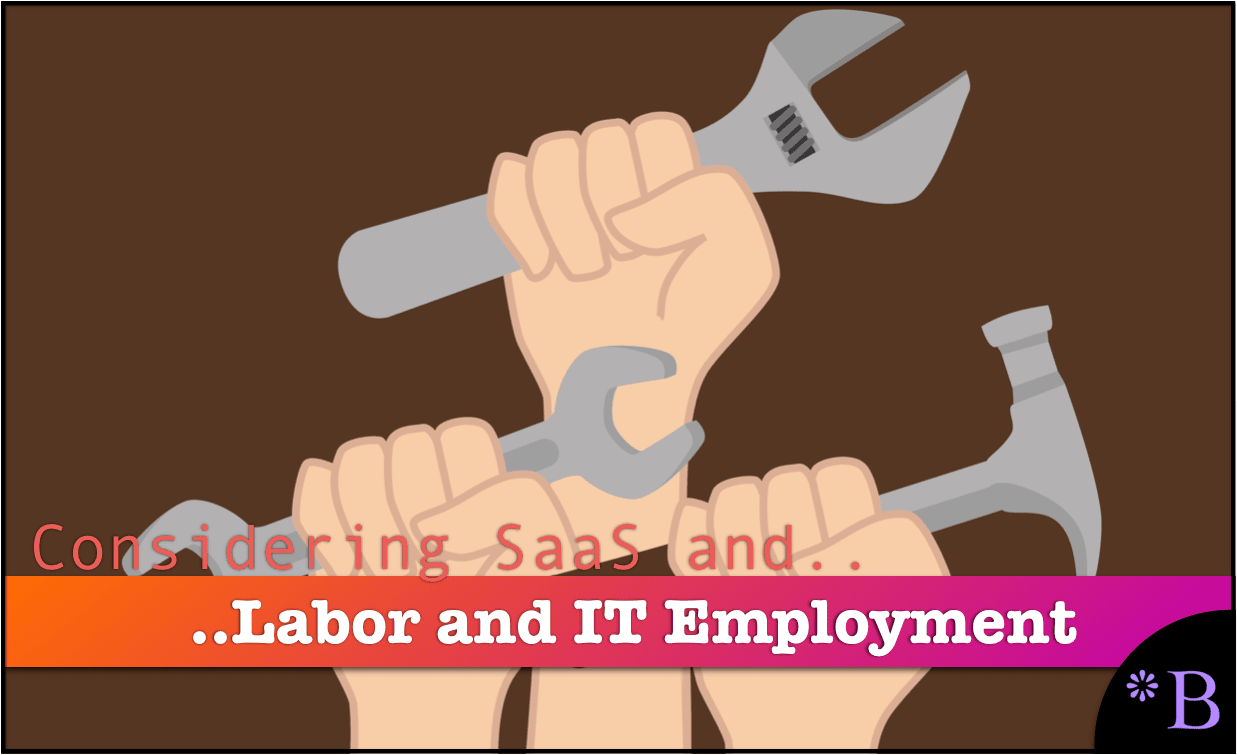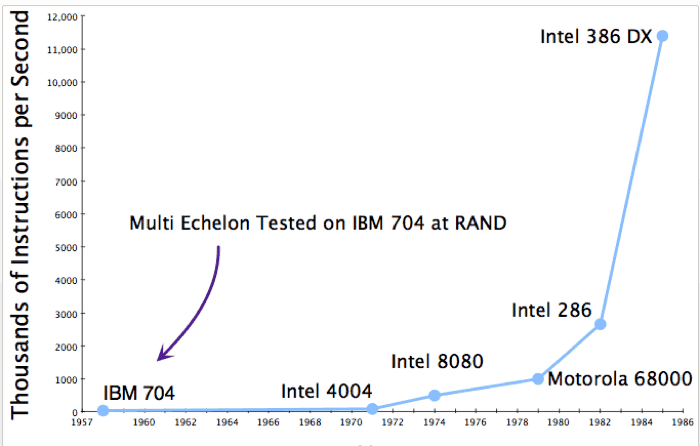How to Understand How Cloud Changes the Labor Needs in IT
Executive Summary
- Most of the growth in the IT space is in cloud applications and databases.
- The implications of the far more efficient cloud modality are not being considered.

Introduction
In this article, you will learn about the impact of Cloud on employment, which is hard to find much at all written.
I will cover the following issues:
- How Cloud Vendors Operate
- Examples of Trends in Major Industrial Employment
- Impacts on IT Employment
- The On-Premises Consulting Business Model
- Labor Specialization
- Subscription vs. Time & Material Models
The Growth of Cloud
Cloud is now one of the most important trends in IT. Cloud is consuming most of the growth in software. According to the Yankee Group, 87% of people who have used Cloud would recommend it to others. Cloud provides genuine benefits, including the following:
- Faster Implementation
- Lower Maintenance Costs
- Easier Updates
As pointed out in the book Subscription Marketing: Strategies for Nurturing Customers in World of Churn.
“The writing is on the wall, at least for the software industry: for revenue growth, look to subscription based offerings not to traditional, “linear” sales models such as packaged software with perpetual licenses.”
What SaaS or Cloud Actually Is
SaaS and Cloud emerged as a more efficient delivery method of software that leveraged the web infrastructure and database capabilities called multitenant, which means that a single database could serve multiple customers. This allowed a significant reduction in the cost of managing each customer. SaaS and Cloud vendors focused on simpler applications, such as HR, travel, expense management, and CRM. These were applications that most companies could deploy without having to perform customization.
This is what I call the pure state of SaaS or Cloud. This is an important distinction between pure SaaS or Cloud and co-opted or faux SaaS or Cloud. There are several reasons, but one of the most important reasons why is contained in pure SaaS’s or Cloud’s multitenant architecture.
IT Consulting Firm’s Interpretation of SaaS or the Cloud
Both the big on-premises vendors and the consulting companies concluded that if SaaS and Cloud could not be blocked (which they tried to do by playing on security concerns), then the next best thing would be to co-opt the concepts of SaaS and Cloud but undermine the actual model of SaaS and Cloud. Deloitte routinely pulls $50 to $100 million out of clients for low-quality finished systems suddenly wants to be sidelined and see its revenues shrink dramatically because it “believes” in SaaS or Cloud? Because Deloitte is concerned with the value being delivered on projects?
Motivations for the Development of SaaS or the Cloud
Something which goes unmentioned is why SaaS or Cloud was developed in the first place. If we look at some of SaaS or Cloud’s originators, they include Salesforce, Workday, and Arena Solutions. These vendors had in common that they could not have grown very rapidly versus the established on-premises vendors by offering the same thing. The large on-premises vendors still have a costly marketing and delivery model with high payouts to sales reps. Generally, on-premises application sales teams tightly control exposure to the application. The prospect is only allowed to see a demo of the system for short periods of time. Specialized resources called presales consultants to walk prospects through a demo. This approach does not provide or allow a thorough evaluation of the usability of the system. Demonstration consultants, who are very familiar with the application, can do many things that regular users often cannot. Alternatively, when SaaS vendors provide access to a SaaS demo environment, the experience becomes self-guided. This gives the prospect more control and allows them to understand whether the application is a good fit for them in a shorter period of time.
Therefore, to compete, SaaS vendors innovated a different way. They developed software that could be accessed over the Internet, software with low implementation and maintenance costs, and software that could be canceled or not renewed by the customers. Basically, the SaaS vendors provided their customers with a better deal by leveraging technologies that had not existed when the on-premises vendors came to prominence. They offered these things not necessarily because they wanted to but because they had to.
The Impact of Saas or Cloud on Consulting
SaaS or Cloud software implements more quickly than on-premises software. For one apparent reason, the software of multitenant SaaS vendors is already up and running. All that is necessary is to migrate the customer to an existing live instance. There are many benefits of SaaS. According to Nucleus Research, SaaS applications can be developed and deployed five times faster and at half the traditional applications cost. However, in addition to this, SaaS or Cloud software tends to be designed to be easier to maintain. Again, this is a feature of the deployment approach. If vendors know that they will not be charging for consulting but baked into the price of their monthly charge, they will design systems that are inherently easier to configure and manage. That is, the deployment cost falls on them rather than being placed on the customer. For example, all of SAP’s home-developed software is exceedingly difficult to implement and maintain.
This is why SAP generally has the highest TCO in every category of software in which it competes. See the Brightwork online TCO calculators for extensive details that support this statement. And this high TCO is the reason that Deloitte so adores SAP. There is an inverse relationship between the implement-ability of software and its cost to perform the implementation for obvious reasons. Deloitte will generally not recommend pure SaaS software because then there is no reason for Deloitte. Therefore, Deloitte recommends the most challenging software to install that drives the highest number of billing hours. Deloitte only has one measurement of its consultants. And it all comes down to billed hours.
How Cloud Vendors Operate
According to the author Anne Janzer, cloud vendors are not profitable when they are first signed up. Rather than the buyer absorbing the risk, the risk is more transferred to the software vendor.
What Cloud Means for Labor
IT has been one of the significant growth areas in labor since mainly computer systems became widely used by businesses in the 1980s. In the US, significant companies always want more H1B visas to expand the tech workforce.
Tech companies have been participating in the long-established and squeaky clean US democratic influence process in the most nuanced and dignified manner possible.
Tech companies have been banging the drum that they need more labor brought in, and one country, in particular, India, is a virtually unlimited source of this type of labor. India is now mostly considered a farm system for US tech companies (including consulting companies, of course) as almost any tech company of any size has an Indian operation. These companies hire Indians in their Indian office. Then they can both use them as foreign labor and bring them into the US on an H1B visa, and other forms of visas that almost always mean US citizenship for both the employee and then portions of their family.
The use of primarily Indian labor has been an enormous engine of profits for US consulting companies as the margins on offshore labor and H1B visa workers (who are often being billed out at the rate of a US citizen) are high the costs are much lower. And they love it!

Where Do Large Consulting Companies Stand on the Cloud?
In the previous article, I corrected a mistaken article in the Wall Street Journal blog that stated that SAP was moving its applications quickly to the Cloud. However, SAP is not the only company that is against the Cloud. The giant consulting companies like IBM and Accenture have as little interest in the Cloud, as it undermines their entire business model.
Large consulting companies make their money off the difference between what they pay consultants and what they bill consultants to the client. This margin is quite high and covered in this article. The more consultants they can put on a project, the more money they make. For this reason, they are wedded to the current wasteful and inefficient on-premises model. (raise your hand if you think installing applications at every location, updating the application in a decentralized format is competitive to centrally installed and administered software). They are opposed to any improvement in software implementation efficiency in general as it means fewer costs and fewer, far fewer consultants on-site, and therefore fewer revenues.
How Large Consulting Companies Put Brakes on the Cloud’s Growth
They continue to have a great deal of influence, and so they recommend against cloud solutions. Most likely playing up security concerns and generally pushing the idea out into the future. It’s straightforward; cloud solutions mean more income for best-of-breed vendors, less profit for monopoly software vendors, and far less consulting revenue. If cloud computing were to become the norm, far fewer people would be required in information technology in general as cloud computing is so much more efficient than the on-premises model. In this way, large consulting companies are significant impediments to software implementation efficiency.
To the Moon?
The assumption is clearly that IT growth will continue indefinitely. However, that has never been true for any new industry.
It should always be remembered that IT as an industry is roughly four decades (that is four decades old at any scale, computers go back much longer than that).
However, changes are afoot in the form of cloud applications, eventually taking over enterprise software. Before we get into that, let’s take a brief segue into labor and industrial history because this shows how things tend to work overtime and how employment in a sector can rise and fall.
Examples of Major Industrial Employment
There have been several significant areas of employment that all industrialized countries have gone through. From analyzing these stages, a pattern emerges of the consumption of employment by each major category.
- In 1947, manufacturing was 24 percent of all payrolls. In 2009, manufacturing employment was 11 percent measured the same way.
- In 1947, agriculture was 8.2 percent of the payrolls. In 2009 it was 1.2 percent
- In 1947, finance, insurance, and real estate were 10.5 percent of all payrolls. In 2009, it was 21.4 percent.
- In 1947, health care and social services went from less than 2 percent to 7.3 percent.
There is an inverse relationship between the efficiency of a sector and its employment. Let us go over that again because it is easy to miss.
The productivity of a sector is how much output can be produced for a given input. The higher the productivity, the less input — which can be inputs of all types — labor included — are necessary to meet a given output. If the output consumed stays the same, but efficiency increases, then input declines. Hence less employment.
Manufacturing saw significant efficiency gains from 1947 to 2009, while finance, insurance, real estate, health care, and social services did not (in fact, they become significantly less efficient than they were in 1947, hence at least part of the reason for their employment growth).
Evidence of the efficiency in manufacturing is that since 1944 US industrial output has increased by six.
The Lesson?
All of this is to say that employment in a sector does not stay the same over time.
Significant changes in employment are often due to technologies. Both agriculture and manufacturing significantly increased the use of machinery from 1947 to 2009. Only looking at some of the agricultural and production equipment used today makes this apparent.

Harvesting grain this way is super-efficient. Imagine that at one-time, grain was harvested by hand.

This is a textile loom from my book Process Industry Manufacturing Software: ERP, Planning, Recipe, MES & Process Control. I love showing this picture because it illustrates the incredible efficiency of specialized manufacturing machinery. Once again, the fabric used to be woven by hand.
Understanding the On-Premises IT Delivery Model
Computers have massively increased in performance, which has led to the ability to do many unthinkable things in the recent past. It is hard to look at a chart of computer performance and not come away impressed. The increases are so significant that they can’t be shown on a graph due to the growth rate.

This graphic is from my book Inventory Optimization and Multi-Echelon Planning Software. I had to stop the graph in 1986, and if you extend the timeline, the new enhancements become imperceptible from one another.
However, it’s important not to confuse computer hardware improvements with either…
- The benefits received from computers and software
- The efficiency of the software delivery
This is because inputs do not directly translate to outputs. That is, neither of these two factors has increased anywhere near the rate of computer hardware improvements.
In this article, I will leave out the first topic (benefits received) as that is a separate analysis and only focus on the efficiency of software delivery, as it is central to understanding how the Cloud will change IT employment.
Impacts on IT Employment
Currently, there are two central parts of IT employment I wanted to discuss. One is internal IT departments, and the second is consulting, both of which I will describe with the standard on-premises software model. This has been the dominant software model and continues to be the most common.
The on-premises model is what Cloud is replacing.
- IT Departments: IT departments are primarily the maintainers of systems that outside consulting firms have implemented.
- Consulting: Consulting firms specialize in the implementation of new systems. Their role is to eventually transition knowledge to the IT departments so that they may maintain the applications and all the supporting areas such as databases, IT infrastructure, etc..
The On-Premises Model
Under the on-premises model, the efficiency of both major areas of IT is significantly compromised.
- For the IT Department: The IT department must maintain many individual applications and with a high ratio of a variety of applications and supporting items (databases, ETL tools, etc.) per person employed. Per person, IT departments have a limited ability to become as proficient as they would like to be in any of the applications and supporting items. IT support tends to be understaffed, and IT resources spend less time helping users understand how to work with the system and more things like fixing tickets. This makes it difficult for system use to progress, and in fact, it often regresses from the implementation stage. I know something about this as I have spent part of my career trying to fix already implemented systems. The amount of functionality that is used and used correctly can be shocking.
- For IT Consulting Companies: IT consulting companies can be large, medium, or small. However, the vast majority of IT consulting is delivered by large well-known consulting companies. While it may seem that their size would mean that they could support many applications, they specialize in the most profitable applications — those that allow them to bill the most hours. Therefore, their skills are very narrow when compared to the available applications that exist. That is why moving to the Cloud completely undermines their business model. They have no financial incentive to support Cloud, and therefore, in their “opinion,” one should move towards Cloud slooooooowly. Perhaps never, if possible. Now more than perhaps ever, listening to the big consulting firms is a huge impediment to progress.
The On-Premises Consulting Business Model
As for consulting under the on-premise model, a combination of high cost, higher likelihood of failure, long implementation timelines, and poorer software selection all exist. I cover this last topic in the article The Effect of SaaS on Software Selection. Some savvy companies have decided to follow a policy where they maintain no internal servers.
“When we started our company, one of the first things we put in place was a formal, no-server policy. We will not buy servers for any reason. Even product development is done in the cloud.” – Vaidya Iyer, AppsFreedom
Vaidya is onto something here. Maintaining your servers is only becoming less necessary as, every year, the cloud options expand.
All of this decentralized IT infrastructure and decentralized workforce to manage the IT infrastructure is simply inefficient. And this inefficiency is a primary reason why so many people are working in IT in either IT departments or IT consulting.
But SaaS may be marking an increase in IT efficiency, which means fewer people will be needed to deliver the same, or I would predict far higher capabilities.
The Common Thinking on H1B
The conventional wisdom has been that due to a shortage of IT talent, importing IT, workers, and India continually is necessary. This is because there are not enough Americans with the specific IT skills that exist in India. The big consulting firms get several actual skills, but they also get an entirely compliant worker. Indian’s will never push back on the company that hires them. And compliance is critical because these firms have many lies to tell.
What is entirely left out of the analysis is how the large consulting companies use the H1B visa employees to lie to their customers.
The Real Story on On-Premises IT Implementation
The biggest importer of H1-B visa workers from India is the large consulting companies such as IBM-Deloitte-Accenture-KPMG-Cap Gemini-etc.. w. These firms follow a margin and billable hour, model. For this reason, they perpetually recommend the most expensive and hard to implement software. Many good smaller software companies’ products are much easier to implement. However, the consulting model of the big firms is to bill many hours. For this reason, they gravitate towards over-engineered solutions like SAP or Oracle, which are giant entities with significant monopoly power that make no effort to make their software more straightforward to implement.
Hard to Implement Software
Most IT projects do not meet their objectives, and only 50% payback their investment. Secondly, these investments are very high. Some large IT projects are in the 100s of millions of dollars. I have seen wholly misdesigned solutions, courtesy of the big consulting companies. However, they like the fact that the software is difficult to install because it maximizes their billing.
Concentration and Labor Specialization
In the article What SAP Moving to the Cloud Means for Current HANA On-Premises Purchases, I brought up the vital concept of labor specialization in the Cloud. Let us review this here because it is a critical component to understanding cloud efficiency:
“There are all types of efficiency benefits that come from the labor specialization of having on group control an application for so many customers, instead of the decentralized model, called on-premises, where the individuals in the customer’s IT department maintain essentially a single implementation of many different applications. The SaaS/cloud application model simply allows for a higher degree of labor specialization. This is because a team that manages many customers for a single application are far more efficient than the same sized team managing multiple applications for a single customer.”
On-Premises IT Consultants
Cloud implementations don’t take a small army of implementers from consulting companies focused on staying on the account as long as possible. On the other hand, Cloud vendors don’t bring up systems; they add new customers to existing systems. The way they do this is extremely efficient and makes someone like me, who has experience in the old way of doing things, wonder what the future will look like.
Arena Solutions
Arena Solutions is an excellent example of a cloud vendor with a great deal of experience, bringing up new customers quickly. Concerning training, Arena is much more likely to perform remote screen sharing sessions than having Arena Solutions consultants go and camp out at the customer location.
There is an excellent reason for this. Arena Solutions, as with other cloud vendors, is all about rolling their services into a single subscription charge. Therefore, there becomes far less of an incentive to charge on a time and material basis. Like other subscription providers, Arena wants to sell more seats and keep the seats that they have sold continuing to renew their subscriptions. Therefore the incentives are just entirely different for cloud vendors.
Subscription vs. Time & Material Models
Cloud vendors do have professional services, but they are much smaller than on-premises vendors. Secondly, the size of the sales teams is also much smaller than with on-premises vendors. This drastically reduces the costs that the cloud vendor needs to charge, making it difficult for on-premises vendors to compete with them.
This is one reason cloud vendors are rapidly growing, while on-premises vendors are not.
I had a friend recently ask me.
“What is preferable, a situation where the consulting company charges on the basis of time and material (and the customer accepts the risk) or where the company charges a fix fee (where the consulting company takes the risk)?”
Upon reflection, I said that there are problems with both scenarios. However, the best answer is a subscription that is neither time and material nor a fixed fee. I believe that Eric Larkin had it right; the Cloud does a great job of aligning the interests of the customer with the buyer’s interests. And this has been a problem for quite some time in the IT industry.
IaaS or PaaS
Some of the employment will also move towards infrastructure providers like Amazon and Rackspace. Software vendors will have to decide whether to host themselves or have their software hosted on one of these companies’ servers. Vinnie Mirchandani, in the book SAP Nation: A Runaway Software Economy, had the following important point about the labor which is used in these environments.
“…I told them the data centers at Google, Facebook, and Amazon are impressive “factories.” These 500,000 square foot behemoths, servicing billions of users, are supported by a handful of staff with the latest in cooling efficiencies an security features. In contrast, the SAP economy is people-intensive, with labor constituting 70 percent of the costs in our model.”
Conclusion
I don’t recall running into anyone writing about these aspects. Everyone likes to talk about the Cloud, but there are so many unaddressed areas of the Cloud. I have a lot more to say about the Cloud in future articles.